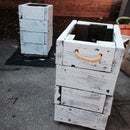Introduction: Walnut Tray
Once again, while seeking a new source of inspiration, I stumbled across a great furniture designer by the name of Andre Joyau : http://andrejoyau.com. He has an eye for literally raw elements combined with simple elegant design and lines. I did not want to commit to a long term project. I wanted to start and end a project in 3 to 4 hours tops. One of the accessories that caught my eye was this tray: http://andrejoyau.com/collection/accessories/accessories/tray6565
Step 1: The Plan
Step 2: Cutting Down the Walnut
I set out the cut the parts.Wood used: locally harvested Walnut.
First the bottom part of the tray: 11” by 22”
Next the sides of the tray: 2” by 22”
Cut the sides at 45 degrees:
All pieces are ready for dry fit or assembly if you so choose. While this project is simple enough that it might not require dry fit, it is always good to do so in my opinion just to see what the final product will look like. Also, if you are not lucky enough to have access to a wood that is 11" in width, you can opt to glue boards together. I would recommend book matching as much as possible for a nice clean/symmetrical look.
Step 3: Dry Fit and Glue Up
After a quick dry fit and being quite happy with the outcome, gluing comes next. Nothing major here. No need for any biscuits on this tray as the grain is long and will hold very well. Allow for 24 hour curing.
Step 4: Final Touches
After un-clamping the tray, I gave the tray a good sanding along the edges, side and top/bottom. No need to be too refined about the sanding. I started with 60 grit and jumped to 100 after that. I wanted to leave a little bit of unrefined look. You can goo as high as you want. Once the sanding is done, I used Tung oil ( a non toxic oil) to bring the tray to life. Can also apply sunflower seed oil or lemon oil if you so choose. It will have the same effect and pose zero toxicity issues.
You can apply as many coats as you like. I usually do 2 and every year or a need by need basis apply another coat to bring it to life if guests are coming over. You are done.
Step 5: Side by Side Comparison, Final Thoughts.
For less than 4 hours of "real" labor and some waiting, this tray looks great and I am very pleased with it. Wath I like about the design (which again is not mine) is that should one side become dirty, simply flip it over.
At the same time the tray will not contain any liquid spills at all as there is no lip around the main center of the tray. Which leads me to variations and improvements:
1. One could opt to frame the entire tray without any breaks in the framing, using the same wood and use leather handles of a lighter color and say red stitching as a variant and to contain any spills.
2. One could use a router and route out a lip on both sides to make it spill proof.
Let me know your ideas/variations. I have compiled at least 5 different variations that would work and are esthetically appealing. Don't be limited to square or rectangular shapes either, I think a round shape would be great ... a little challenging as wood steaming and bending will have to happen (or lamination for an easier solution), but beautiful none the less.
Once again, thank you for looking at my insturctable. I look forward to your votes, comments and questions.
DN











